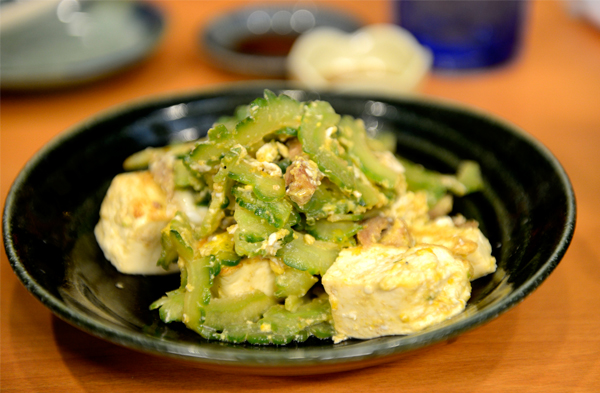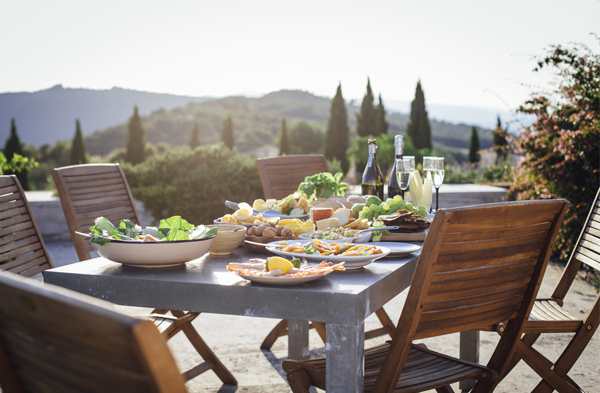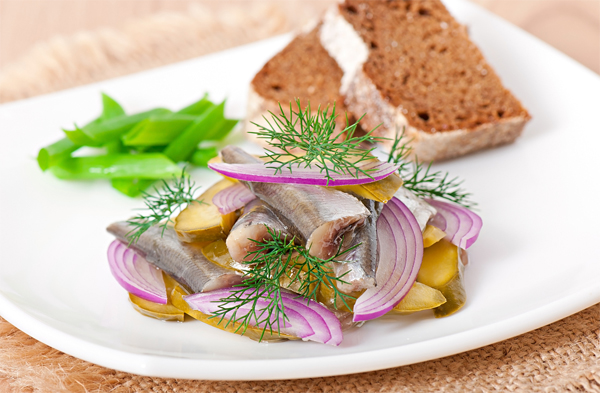1 – The Okinawa diet

The Okinawa diet refers to the eating habits of the people belonging to the Ryukyu Islands, of which Okinawa is the largest. This area of Japan is believed to hold the world’s largest population of centenarians, with some estimates putting the ratio at as many as 50 per 100,000 compared to the 10-20 centenarians per 100,000 found in the USA.1
With such a large population of centenarians, many are pointing at the Okinawa diet as the explanation. This food regime places a high value on colourful vegetables, especially the purple sweet potato, as well as soy and legumes. Rice is traditionally served with most meals and is fermented to produce a wine known as ‘sake.’ Meat and dairy are normally eaten in small amounts and used to flavour dishes rather than act as the main focus while herbs such as turmeric and ginger are used to season soups and fish dishes.
The people of Okinawa also abide by a Confucian teaching known as ‘hara hachi bu,’ which refers to the idea of eating mindfully and slowly until they are almost full, but not quite sated. Compared to the rest of Japan, their sugar intake is very low and they normally consume around 1200 calories a day.
Not to mention, there’s plenty of antioxidant-rich green tea served at mealtimes and drank regularly throughout the day! In addition to food, the people of Okinawa are also very active, spending most of their day outdoors, working well into their eighties and partaking in various forms of aerobic exercise.
How does it compare to the UK?
When it comes to the main meal of the day, we usually see meat as the main event rather than a flavour which can cause some problems, particularly if each meal contains an all too generous helping of processed meat. There’s also not much in the way of mindful eating going on as most of us eat breakfast on-the-go, lunch at our desks and dinner in front of the television.
What can we learn?
While it might be tricky for us to replicate their diet exactly, the Okinawa diet does place an emphasis on bright, colourful fruit and veg, including fermented foods and plenty of antioxidant-rich herbal tea. Colourful fruit and veg are usually rich in beta-carotene, fibre and other antioxidants so there’s definitely a lesson to be learnt there.
Our friends at Jan de Vries have already spoken about the benefits of anti-inflammatory turmeric but the way the Okinawa diet treats meat and their attitude towards mindful eating is exemplary. This line of thinking is completely in line with that of our founder, Alfred Vogel who emphasised the importance of thoroughly chewing food and the benefits that it could have for our digestive system.
1http://www.okicent.org/cent.html
2 - The Mediterranean diet

The Mediterranean diet has made numerous headlines over the years and is believed by many to be the key to a long and healthy life, with research even demonstrating that it can lower the risk of heart disease and brain shrinkage2 as well as high blood pressure and type-2 diabetes.
A typical Mediterranean diet is rich in fruit and veg, such as artichokes, garlic, lemons and tomatoes. It also involves plenty of fresh oily fish such as mackerel and herring which are rich in essential fatty acids. The produce they eat is largely organic with the Mediterranean enjoying comparatively clean soil with low levels of pesticides and other chemical toxins.
Lean meat is used sparingly and vegetable oils such as the famous olive oil are often used to drizzle over salads. In rural areas of Greece and Italy, feta cheese and yoghurt are often homemade and sheep and goat’s milk (usually considered to be easier on the digestive system) are often used instead of cow’s milk.
Regular exercise again plays a role in everyday life, but it really makes the Mediterranean stand apart is their attitude towards life. Despite working very hard, they enjoy low levels of stress and a great sense of community, with meal times being considered a time to come together as a family.
How does it compare to the UK?
Going organic is a relatively new trend in the UK, with many still viewing organic produce as being overpriced. Many in the UK, particularly in urban areas, also don’t enjoy the same feeling of community and stress levels are high. White fish is also traditionally preferred to oily fish and quick meals of convenience are usually preferred over cooking meals from scratch.
What can we learn?
Similar to the Okinawa diet, the Mediterranean diet is full of fresh fruit and vegetables and oily fish in addition to the plant based olive oil. This intake of valuable antioxidants and essential fatty acids is incredible when it comes to maintaining a healthy heart and, in addition to low stress levels, a healthy mind.
The people of the Mediterranean also aren’t afraid of using alternatives to dairy milk such as goat’s milk, which is gentler on the digestive system. They also aren’t afraid of making things from scratch, including wholemeal bread and pasta. While cooking everything from scratch isn’t always practical, I would still try to incorporate at least a few home cooked meals into your weekly routine.
It’s also worth taking on board their attitude towards work and life in general. The UK has a real problem with stress so it never hurts to slow down and appreciate those around you. Try to eat food at the dinner table as a family and get outdoors to enjoy the fresh air!
2https://www.mayoclinic.org/healthy-lifestyle/nutrition-and-healthy-eating/in-depth/mediterranean-diet/art-20047801
3 – The Nordic diet

While the Okinawa and Mediterranean diets are comparatively well-known in terms of nutrition and health, a new diet has started to gain popularity over the years. Hailing from Scandinavia, and following the ‘New Nordic’ cuisine movement, the Nordic diet revolves around eating plenty of fatty fish, root vegetables, berries and rye bread.
It’s considered to be more achievable than the Mediterranean diet because it relies on food products found in countries with a similar climate to the UK, such as kale, cabbage and potatoes. Rich in nutrients and essential fatty acids, the Nordic diet also introduces antioxidant-rich berries such as the famous blueberry, lingonberries and cloudberries, which are also a great source of omega-3 fatty acids.
They also don’t lack for their own herbs and spices, including dill, sometimes known as the ‘garlic of the North,’ and also drink plenty of oat milk. They also involve a lot of rapeseed oil in their cooking which is bursting with vitamin E and is believed to contain more omega-3 fatty acids.
Research also appears to be backing the Nordic diet with one study published in the Journal of Internal Medicine3 linking the diet with low levels of inflammation and cholesterol, with further studies also indicating its benefits for blood pressure and weight management.4
How does it compare to the UK?
The Nordic diet places an emphasis on avoiding processed food and perhaps nothing demonstrates this better than their traditional rye bread, a high fibre alternative to the white bread found on supermarket shelves. However, the diet does utilise similar ingredients to those found in the UK, making great use of root vegetables and fresh fish.
What can we learn?
While both the Okinawa and Mediterranean diet utilise ingredients that are often costly and not always in season year round. The Nordic diet has the advantage of using similar ingredients that are often found in British cooking, including root vegetables and fish.
What makes the Nordic diet stand out in comparison to other diets on this list is its incorporation of antioxidant-rich berries, such as blueberries and cloudberries. The Nordic diet also uses alternatives such as oat milk, which is low in fat but high in fibre, as well as birch water, which is thought to support the immune system.
If there’s one lesson to take away from the Nordic diet, it’s that fresh is always best. The Nordic diet also places a high value on fresh food, avoiding processed alternatives. In the UK, processed foods are a real issue, with white bread and other forms of refined carbohydrates often forming the bulk of each meal.
3http://onlinelibrary.wiley.com/doi/10.1111/joim.12044/full
4https://www.ncbi.nlm.nih.gov/pubmed/24257725
What can you take away from this list?
It might seem as though I’m having a bit of a go at the UK, painting an unfavourable picture of a nation addicted to junk food and microwave meals. This is far from the truth – in fact the UK is really starting to wake up in terms of health and nutrition and more and more of us are turning away from processed foods in favour of healthier alternatives. Hooray!
However, it’s still important to try and learn from other cultures. So what has looking at each diet taught us?
- Less is more when it comes to meat: Across the board, meat was only ever used to flavour food and wasn’t a daily occurrence.
- Fresh is best: Always opt for fresh, organic ingredients when possible, particularly when it comes to fruit and veg!
- Don’t be afraid of fish: Oily fish is an excellent source of fatty acids and, if you’re not vegan or vegetarian, don’t be afraid to eat more!
- When it comes to fruit and veg, more the merrier: Try to get a colourful plate that includes a bright array of whatever is in season!
- Choose your oil carefully: Olive oil, coconut oil and rapeseed oil are all great and nutritious alternatives to traditional cooking oil so don’t be afraid to experiment!
- Consider dairy alternatives: There’s an incredible selection of plant-based milks out there – just read our guide to dairy-free milk for more information!
- Ferment, ferment, ferment: A great source of friendly gut bacteria, fermented foods are definitely on trend at the moment!
Food should be enjoyed so while it’s important to try and incorporate healthy elements to your diet, make sure you’re giving what’s on your plate the attention it deserves. Don’t rush mealtimes, use them as a time to get together with your friends and family and enjoy each other’s company with some great, delicious food!





 Looking for our products in a store near you?
Looking for our products in a store near you?
